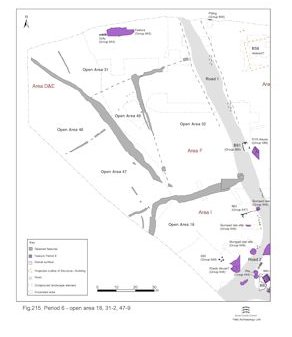
Assuming the continuance of Roads 1 and 2 into the late 4th century, Open Area 18 may survive as a distinct entity until the end of the Roman period (Figure 215). Although its northern boundary is not renewed or cleared, the partly filled ditch 25027 may persist as a boundary and certainly continues to accumulate material in the late 4th century.
In its interior, two buildings are identified, though further structures could occupy uninvestigated parts of the enclosure - though no such indications are apparent on the pre-excavation plan of this vicinity. Other than the accumulation of material in the slump hollows of earlier features alongside Roads 1 and 2 (5806, 13138, 13358), there are no features such as pits accompanying these late structures.
No Early Saxon activity, either use or disuse, is apparent within OA18.


Building 62 (13356, 13490 Group 647) is constructed on the eastern side of OA18, fronting onto Road 1, in the Late Roman period. A foundation slot, 0.46m wide and 0.08m deep is traced for a distance of 10m (Figure 224). It is filled with clean orange clay that appears to be a packing deposit around beamslot 13356. This slot is near vertically sided and flat bottomed and is filled with black silt. It is possible that this is no more than a drain, but the slot more closely resembles the remains of an in situ rotted sleeper beam. Apart from a short spur that runs off to the south, no more of the structure is evident on the surface of the surrounding unexcavated dark silts. Nothing more of the form of this building is known, though it might be reasonable to assume its eastern side coincides with the road edge. No dating evidence was recovered and only its relationship with Period 5 pit 13358 serves to indicate its late date.
A group of four post-holes (5668, 5678/13181, 5759, 18042 Group 648), all similar in size, shape and fill, define a small rectangular structure, some 1.8m by 1.4m in plan. Interpreted as a four-post storage structure or else something like a rack, post-hole 5668 contains a pair of copper-alloy tweezers (SF2857).
As already noted, silt accumulations (Group 646) on and alongside Road 2 extend into the interior of OA18.
In addition, some of the larger features along the western side of Road 2 at its junction with Road 4 (?well 5806, pits 13138 and 13358) continue to accumulate material in their tops to the end of the 4th century and perhaps beyond (i.e. deposits 5763, 5768, 5797, 13064, 13216 Group 649). The pottery assemblage from the slump hollow of 5806 is particularly noteworthy (KPG39). These also extend beyond the confines of the underlying features and into the interior of OA18 and are interpreted as layers, rather than fills per se, representing the truncated remains of wider spreads of late silts and artefact scatters.
Deposit 13216, overlying pit 13358, is particularly interesting. It contains 60kg of bonded opus signinum and tile, otherwise rare on the site, as well as large quantities of loose brick and tile, stone and tesserae. A similar dump, 5768, in the subsidence hollow of well 5806 also includes a small quantity of opus signinum. Whether this building material necessarily derives from the demolition of a late building or buildings is undetermined. The tile could as readily derive from a smaller structure such as a kiln or corn-dryer.
Internet Archaeology is an open access journal based in the Department of Archaeology, University of York. Except where otherwise noted, content from this work may be used under the terms of the Creative Commons Attribution 3.0 (CC BY) Unported licence, which permits unrestricted use, distribution, and reproduction in any medium, provided that attribution to the author(s), the title of the work, the Internet Archaeology journal and the relevant URL/DOI are given.
Terms and Conditions | Legal Statements | Privacy Policy | Cookies Policy | Citing Internet Archaeology
Internet Archaeology content is preserved for the long term with the Archaeology Data Service. Help sustain and support open access publication by donating to our Open Access Archaeology Fund.